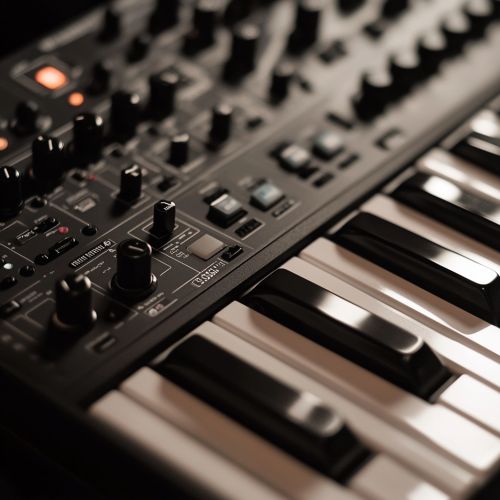LFO: Difference between revisions
(Created page with "== Introduction == LFO, or Low-Frequency Oscillation, is a fundamental concept in the field of synthesizer technology and electronic music production. It refers to an electronic signal, typically below 20 Hz, which is used to modulate various parameters of sound synthesis, such as pitch, amplitude, or filter cutoff frequency. This modulation can create a wide array of effects, from subtle vibrato to dramatic sweeps and rhythmic pulsations. LFOs are inte...") |
No edit summary |
||
| Line 26: | Line 26: | ||
Modern synthesizers often allow LFOs to be synchronized to a [[MIDI|MIDI clock]] or tempo, enabling precise rhythmic modulation in time with the music. Additionally, LFOs can be controlled via various performance inputs, such as modulation wheels, aftertouch, or external control voltage (CV) sources. This flexibility allows musicians to dynamically shape their sound in real-time. | Modern synthesizers often allow LFOs to be synchronized to a [[MIDI|MIDI clock]] or tempo, enabling precise rhythmic modulation in time with the music. Additionally, LFOs can be controlled via various performance inputs, such as modulation wheels, aftertouch, or external control voltage (CV) sources. This flexibility allows musicians to dynamically shape their sound in real-time. | ||
[[Image:Detail-98577.jpg|thumb|center|A close-up of a synthesizer with visible knobs and buttons, focusing on the LFO section.|class=only_on_mobile]] | |||
[[Image:Detail-98578.jpg|thumb|center|A close-up of a synthesizer with visible knobs and buttons, focusing on the LFO section.|class=only_on_desktop]] | |||
== Applications in Sound Design == | == Applications in Sound Design == | ||
Latest revision as of 07:41, 19 October 2024
Introduction
LFO, or Low-Frequency Oscillation, is a fundamental concept in the field of synthesizer technology and electronic music production. It refers to an electronic signal, typically below 20 Hz, which is used to modulate various parameters of sound synthesis, such as pitch, amplitude, or filter cutoff frequency. This modulation can create a wide array of effects, from subtle vibrato to dramatic sweeps and rhythmic pulsations. LFOs are integral to the design and operation of synthesizers, both analog and digital, and are widely used in sound design, music production, and live performance.
Historical Background
The concept of LFOs dates back to the early days of electronic music and synthesizer development in the mid-20th century. Early pioneers like Robert Moog and Don Buchla incorporated LFOs into their modular synthesizers, allowing musicians to explore new sonic territories. The introduction of LFOs enabled the creation of dynamic and evolving soundscapes that were previously impossible with traditional acoustic instruments. As technology advanced, LFOs became a staple feature in both hardware and software synthesizers, contributing significantly to the development of genres such as ambient, techno, and dubstep.
Technical Overview
Basic Principles
An LFO is essentially a waveform generator that operates at low frequencies, typically ranging from 0.1 Hz to 20 Hz. The waveform produced by an LFO can take various shapes, including sine, square, triangle, sawtooth, and random (or sample-and-hold). Each waveform shape imparts a distinct modulation characteristic to the sound. For instance, a sine wave LFO applied to pitch modulation results in a smooth vibrato effect, while a square wave LFO creates a more abrupt, on-off tremolo effect.
Modulation Targets
LFOs can modulate a wide range of parameters within a synthesizer. Common targets include:
- **Pitch Modulation**: Alters the frequency of the oscillator, creating vibrato or siren-like effects.
- **Amplitude Modulation**: Varies the volume of the sound, producing tremolo or rhythmic gating effects.
- **Filter Modulation**: Changes the cutoff frequency of a filter, resulting in sweeping or pulsing tonal changes.
- **Pulse Width Modulation**: Modifies the duty cycle of a pulse wave, affecting the harmonic content and timbre.
Synchronization and Control
Modern synthesizers often allow LFOs to be synchronized to a MIDI clock or tempo, enabling precise rhythmic modulation in time with the music. Additionally, LFOs can be controlled via various performance inputs, such as modulation wheels, aftertouch, or external control voltage (CV) sources. This flexibility allows musicians to dynamically shape their sound in real-time.


Applications in Sound Design
LFOs are a powerful tool in sound design, offering a wide range of creative possibilities. By modulating different parameters, sound designers can create evolving textures, complex rhythmic patterns, and expressive articulations. In film scoring, LFOs are often used to add tension and movement to soundscapes, while in electronic dance music, they can drive the energy and groove of a track.
Advanced Techniques
Polyphonic LFOs
In polyphonic synthesizers, each voice can have its own independent LFO, allowing for intricate and evolving modulations across multiple notes. This capability is particularly useful for creating lush, animated pads and complex arpeggiated sequences.
Audio-Rate Modulation
While LFOs traditionally operate at low frequencies, some synthesizers allow LFOs to function at audio rates, blurring the line between LFOs and oscillators. Audio-rate modulation can produce unique timbral effects, such as frequency modulation (FM) synthesis, where the modulating signal is within the audible range.
Modulation Matrix
Many modern synthesizers feature a modulation matrix, a flexible routing system that allows users to assign LFOs to multiple destinations simultaneously. This setup enables complex and interdependent modulations, facilitating the creation of highly dynamic and expressive sounds.
Conclusion
LFOs are an essential component of modern synthesis, providing a versatile means of modulating sound parameters to achieve a wide variety of effects. Their ability to shape and animate sound has made them indispensable in electronic music production and sound design. As technology continues to evolve, the role of LFOs in shaping the future of music and sound remains significant.
